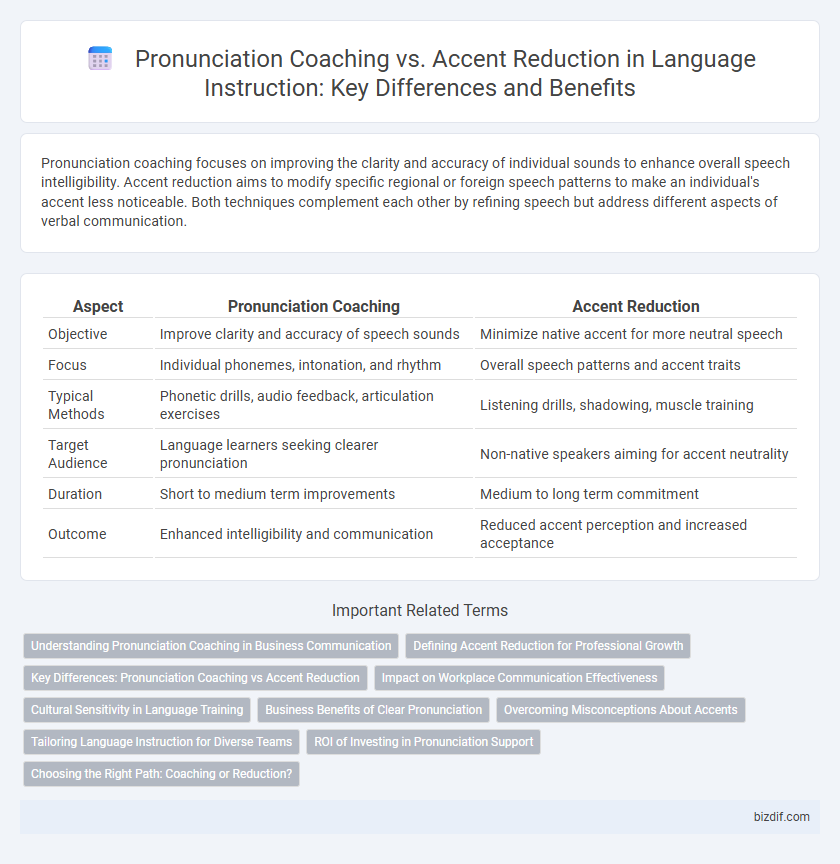Pronunciation coaching focuses on improving the clarity and accuracy of individual sounds to enhance overall speech intelligibility. Accent reduction aims to modify specific regional or foreign speech patterns to make an individual's accent less noticeable. Both techniques complement each other by refining speech but address different aspects of verbal communication.
Table of Comparison
| Aspect | Pronunciation Coaching | Accent Reduction |
|---|---|---|
| Objective | Improve clarity and accuracy of speech sounds | Minimize native accent for more neutral speech |
| Focus | Individual phonemes, intonation, and rhythm | Overall speech patterns and accent traits |
| Typical Methods | Phonetic drills, audio feedback, articulation exercises | Listening drills, shadowing, muscle training |
| Target Audience | Language learners seeking clearer pronunciation | Non-native speakers aiming for accent neutrality |
| Duration | Short to medium term improvements | Medium to long term commitment |
| Outcome | Enhanced intelligibility and communication | Reduced accent perception and increased acceptance |
Understanding Pronunciation Coaching in Business Communication
Pronunciation coaching in business communication emphasizes clear articulation of sounds and stress patterns to enhance listener comprehension and professional credibility. Unlike accent reduction, which aims to modify regional speech characteristics, pronunciation coaching focuses on mastering universally understood phonetic elements essential for effective interaction in diverse corporate environments. Improving these specific pronunciation skills enables clearer messaging, reducing misunderstandings and fostering stronger client and colleague relationships.
Defining Accent Reduction for Professional Growth
Accent reduction focuses on minimizing regional or foreign speech patterns to enhance clarity and professionalism in workplace communication. It targets specific phonetic features such as vowel sounds, intonation, and stress patterns to align with standard American or British English pronunciation. Effective accent reduction training improves verbal intelligibility, fosters better interpersonal connections, and supports career advancement in global business environments.
Key Differences: Pronunciation Coaching vs Accent Reduction
Pronunciation coaching focuses on teaching the specific sounds and intonation patterns of a language to improve overall clarity and fluency. Accent reduction emphasizes minimizing regional or native language accents to achieve a more neutral or target-language accent. Key differences include pronunciation coaching targeting sound accuracy and rhythm, while accent reduction targets phonetic habits and accent markers influenced by a speaker's first language.
Impact on Workplace Communication Effectiveness
Pronunciation coaching enhances clarity by teaching precise sounds, intonation, and stress patterns, which directly improves workplace communication effectiveness. Accent reduction targets minimizing regional or foreign accent influence, fostering greater mutual understanding and reducing potential biases. Both methods contribute to smoother interactions, but pronunciation coaching offers more immediate gains in comprehensibility critical for professional settings.
Cultural Sensitivity in Language Training
Pronunciation coaching targets improving clarity and accuracy of speech sounds, while accent reduction aims to minimize regional or foreign accents to enhance comprehensibility. Incorporating cultural sensitivity in language training ensures respect for learners' linguistic backgrounds, fostering an inclusive environment that values diversity rather than enforcing homogenization. Effective programs balance technical pronunciation improvement with appreciation of cultural identity, promoting both communication skills and self-confidence.
Business Benefits of Clear Pronunciation
Clear pronunciation enhances effective communication, reducing misunderstandings and fostering stronger business relationships. Pronunciation coaching targets sound accuracy and speech clarity, improving overall intelligibility in professional settings. Accent reduction refines specific speech patterns but may not address broader clarity issues crucial for global business success.
Overcoming Misconceptions About Accents
Pronunciation coaching targets improving clarity and correct sound production, while accent reduction focuses on minimizing a regional or foreign accent. Misconceptions often suggest that accents are flaws, but embracing accent diversity enriches communication and cultural identity. Effective language instruction balances pronunciation skills with respect for individual linguistic backgrounds.
Tailoring Language Instruction for Diverse Teams
Pronunciation coaching emphasizes mastering the sounds and rhythm of a language to enhance clear communication, while accent reduction targets minimizing regional or native language influences to achieve a more neutral accent. Tailoring language instruction for diverse teams requires assessing individual linguistic backgrounds and communication goals to design personalized coaching strategies that foster inclusivity and improve team collaboration. Effective programs incorporate cultural nuances and practical practice to balance intelligibility with natural speech patterns.
ROI of Investing in Pronunciation Support
Investing in pronunciation coaching yields a higher ROI by enhancing overall communication clarity, which directly impacts professional and social interactions. Unlike accent reduction, pronunciation support targets specific phonetic accuracy and intonation patterns, leading to faster language comprehension and reduced misunderstandings. Improved pronunciation fosters better listener perception, increasing confidence and career advancement opportunities in global marketplaces.
Choosing the Right Path: Coaching or Reduction?
Pronunciation coaching enhances overall clarity and communication skills by improving sound production, intonation, and rhythm, while accent reduction targets minimizing specific regional or foreign speech traits for better intelligibility. Selecting the right path depends on whether the goal is to build confidence in speaking diverse contexts or refine speech to align more closely with a target accent. Evaluating individual needs, linguistic background, and professional requirements ensures effective language instruction tailored to personal or career objectives.
Pronunciation coaching vs Accent reduction Infographic

 bizdif.com
bizdif.com